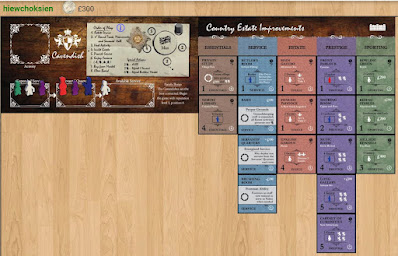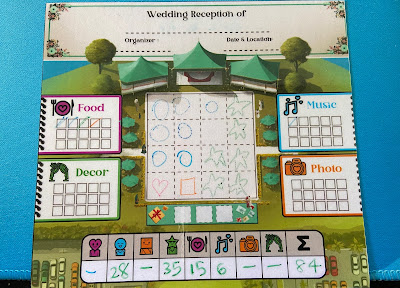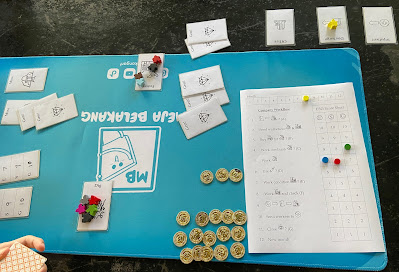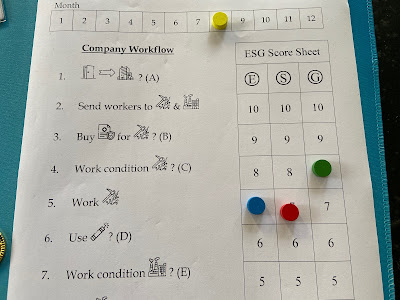The Game
Heat: Pedal to the Metal is the major release from Days of Wonder in 2022. It is a game about car racing. I have never been a particular fan of racing games. But this is Days of Wonder. That means quality products. The initial reviews have been positive. So I have been curious to give it a go. I arranged a time to try it on
BoardGameArena.com.
I asked Allen and Han to play with me. Although we had only the three of us, we were able to fill the game to 6 contestants by adding three bot players. I think this works best. The basic structure of the game is straightforward. Every round, everyone simultaneously selects cards to play. Then in order from leading position to last, everyone plays the selected cards to move their car. The first to cross the finish line wins. If two or more cars cross the line within the same round, the car which overshoots by the biggest distance is considered the winner. To understand the nuances of the game, you have to understand the card play.
Every player has their own deck of cards. The decks are the same for everyone, unless you play with the advanced rules. With the advanced rules, three cards will be swapped out, and you'll get three cards which are unique to you. Every round after you have played cards to move your car, you may choose to discard some cards before you draw cards to replenish your hand. You always replenish to 7 cards.
On your turn you may play 1 to 4 cards. That corresponds to the gear you use. Your car is manual (of course), and you have only 4 gears. Normally you shift gears one step at a time. You can choose to shift by two steps, but doing so costs you a heat card.
Heat cards are the most important mechanism in Heat (hah!). It's a little abstracted, but generally heat cards represent you doing risky stuff with your car and pushing it to its limit, for the sake of being just that little bit faster than your opponents. In the game, it is sometimes a resource, and sometimes a handicap. As a resource, you can spend it to do things you normally can't. E.g. turning a corner faster than the safe speed limit, forcing you car to go some additional steps, and shifting gear by two steps. When heat cards are in the engine area on your player board, they are resources you can spend. When you spend them, you move them to your discard pile. You will later need to reshuffle your discard pile to form a new draw deck, and you will eventually draw heat cards into your hand. When they are in your hand, they are a problem.
Heat cards in your hand clog it up. You can't do anything with them. They reduce your options. They may even make you unable to drive at a higher gear. To get rid of heat cards in your hand, you have to perform the cooling action. The basic way to do this is to drive at a low gear. When you do cooling, you get to move heat cards from your hand to your engine area on your player board. When moved to the engine area, the heat cards become your resource again, allowing you to do fancy things.
Now you have seen the life cycle of heat cards. In this game you are constantly managing this life cycle.
This is the player board. That row at the top lists the actions you perform in a round. It looks like a lot, but only a few are mandatory steps. Others need to be checked and performed only when applicable. The three rectangular areas are your draw deck, your engine area and your discard pile. On the right you have your gear box.

Car racing is won and lost at the corners. Heat captures this very well. There is a safe speed for every corner on the track. When you pass that corner, your speed (i.e. the number of steps you move that round) needs to be less than the speed limit. If you go beyond that, you need to pay a number of heat cards equal to the difference between the speed limit and your speed. You probably need to lower your gear at the corners, because gear = number of cards you play. The struggle is always between low and high gear. You do want to be in high gear as much as possible, so that you play more cards and move further. Ideally along the straight stretches you draw lots of high cards and you play many of them, and at the corners you draw the low cards, and you can still maintain a high gear and play these low cards. But life is not perfect, and the fun is in dealing with what life gives you. You have to decide how low a gear you want to switch to when you make those corners. Remember the other advantage of low gears - you get to do cooling, sending heat cards from your hand to your engine area.
One card type is stress cards. They represent the stress you are under as a driver. They are movement cards, but when you play them, you don't know their movement values yet. Only when you need to resolve movement you'll draw cards from your deck, until you get a basic card (between 1 to 4). Stress cards create uncertainty and risk. It's dangerous to use them at corners, because you may end up going too fast and you may lose control of your car. Spinning out of control is bad news. You will have lost all your heat cards, and your car is reset to the space just before the corner. Your gear is reset to 1. This is not just about wasting one turn. This is putting you at a huge disadvantage. In Heat, every turn counts.
This is a game about hand management. The racetrack looks straightforward. However planning how to make one corner after another is not as simple as it looks. You have to decide when best to use your heat cards. You have to deal with good and bad draws. Heat cards and stress cards normally cannot be discarded. You need to decide when to do cooling, and when to use those stress cards. You have to handle them sooner or later, else your hand will be clogged up, and that diminishes your options.
Everyone picks their cards at the same time, so there is some double guessing. One mechanism in the game is slipstreaming. If your car stops next to or right behind another, you can choose to slipstream and move two extra steps. Trailing players can make use of this to overtake opponents. If you are good at guessing where your opponents will move to, you can reap the benefits.
There are four racetracks in the base game. This above is Italy. The other three are USA, France and UK. You get two game boards, both double-sided.
When using the advanced rules, three of the cards in your deck will be swapped out. You get to play with unique cards. Players will have different abilities. The two white cards above are examples. The first one has a speed of 1, and it allows you to discard up to three stress cards. The second one lets you choose between using it as a 1 or as a 5.
The Play
I played on
BoardGameArena.com, so most of the admin stuff was handled by the computer. When reading the rules, I just skimmed and didn't try to remember all the details. It seemed pretty straightforward, so we learned while we played. Unfortunately for Allen, while still working out the implications of our actions, he found himself losing control of his car at an early corner. He wasted all his heat cards, and his car was reset at the position just before the corner. We learned the hard way how bad spinning out can be. And this is absolutely thrilling. It means we have to be constantly on our toes. One mistake can mean never being able to catch up. We have to be in top form all the time. This is exactly what car racing should be like.
You have to take risks all the time. Safe drivers do not win races. Heat cards are the resource which allow you to take risks. Some risks are calculable and you know you'll spend heat cards to break limits. Some risks are not exactly calculable, e.g. when you play stress cards. You are always thinking about when to take risks and how big they should be. You are always on the edge. You want to squeeze every bit of performance out of your car. Things as innocent as whether to discard cards at the end of a round and which ones to discard are not always simple. If your cards are poor and you decide to discard them, you might end up getting worse cards.
The green player board
The bot players follow specific rules. Since we played on BoardGameArena.com, we didn't bother to understand how the bots worked. We just let the computer handle them. These above are the components for bot players.
The Thoughts
I really enjoyed Heat. The names of the designers, Asger Harding Granerud and Daniel Skjold Pedersen were not familiar, but when I looked them up, I found they are veteran designers and have quite many published games, including one I have played before - Flamme Rouge, a bicycle racing game. Heat certainly piqued my interest in their other games.
Heat is a family strategy game. A little more complex than standard family fare like Ticket to Ride, but it will still work for families. Gamers will enjoy this too. Despite the simplicity, there are interesting and agonising decisions. There are fun tactics. It is simple enough that you can choose to play it in a casual manner. Yet there is some depth to it and you can do a bit of strategising. You can do your card counting and probability calculation if you want to. Whichever way you play, I suggest play with 6 cars, using bots if you are short on humans. It's a lot of fun.


























































